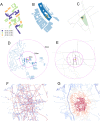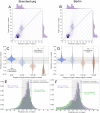Learning from urban form to predict building heights
- PMID: 33296369
- PMCID: PMC7725312
- DOI: 10.1371/journal.pone.0242010
Learning from urban form to predict building heights
Abstract
Understanding cities as complex systems, sustainable urban planning depends on reliable high-resolution data, for example of the building stock to upscale region-wide retrofit policies. For some cities and regions, these data exist in detailed 3D models based on real-world measurements. However, they are still expensive to build and maintain, a significant challenge, especially for small and medium-sized cities that are home to the majority of the European population. New methods are needed to estimate relevant building stock characteristics reliably and cost-effectively. Here, we present a machine learning based method for predicting building heights, which is based only on open-access geospatial data on urban form, such as building footprints and street networks. The method allows to predict building heights for regions where no dedicated 3D models exist currently. We train our model using building data from four European countries (France, Italy, the Netherlands, and Germany) and find that the morphology of the urban fabric surrounding a given building is highly predictive of the height of the building. A test on the German state of Brandenburg shows that our model predicts building heights with an average error well below the typical floor height (about 2.5 m), without having access to training data from Germany. Furthermore, we show that even a small amount of local height data obtained by citizens substantially improves the prediction accuracy. Our results illustrate the possibility of predicting missing data on urban infrastructure; they also underline the value of open government data and volunteered geographic information for scientific applications, such as contextual but scalable strategies to mitigate climate change.
Conflict of interest statement
D.d.B.S and F.A are employed by the commercial company Nam.R. This does not alter our adherence to PLOS ONE policies on sharing data and materials.
Figures





References
-
- Zhu Z, Zhou Y, Seto KC, Stokes EC, Deng C, Pickett ST, et al. Understanding an urbanizing planet: Strategic directions for remote sensing. Remote Sensing of Environment. 2019;228:164–182. 10.1016/j.rse.2019.04.020 - DOI
-
- Bai X, Dawson RJ, Ürge-Vorsatz D, Delgado GC, Barau AS, Dhakal S, et al. Six research priorities for cities and climate change; 2018. - PubMed
-
- Silva M, Oliveira V, Leal V. Urban form and energy demand: A review of energy-relevant urban attributes. Journal of Planning Literature. 2017;32(4):346–365. 10.1177/0885412217706900 - DOI
-
- Creutzig F, Agoston P, Minx JC, Canadell JG, Andrew RM, Le Quéré C, et al. Urban infrastructure choices structure climate solutions. Nature Climate Change. 2016;6(12):1054–1056. 10.1038/nclimate3169 - DOI
-
- Creutzig F, Javaid A, Soomauroo Z, Lohrey S, Milojevic-Dupont N, Ramakrishnan A, et al. Fair street space allocation: ethical principles and empirical insights. Transport Reviews. 2020; p. 1–23.
Publication types
MeSH terms
LinkOut - more resources
Full Text Sources
Other Literature Sources

